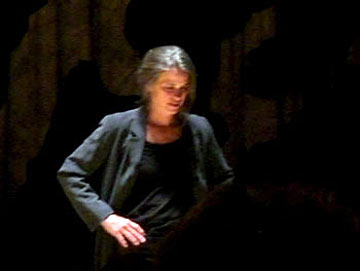
Following is a special report on Season 1 artist Sally Mann, just in from our fabulous former intern Karen Johanne Bruhn, now back home in Copenhagen…
During the past few weeks, American artist Sally Mann has received a lot of attention in Denmark in connection with the opening of her retrospective exhibition, Sally Mann: Photographs at The National Museum of Photograpy in Copenhagen. National TV and newspapers have featured her in numerous interviews and features; the Royal Library screened Steven Cantor’s documentary on Sally Mann, What Remains, and she also gave an artist talk for approximately 500 listeners on a recent sunny Friday night.
The retrospective exhibition focuses on three of Sally Mann’s artistic projects: Immediate Family, Deep South and What Remains. The overall themes in the poetic and romantic—yet nonconformist—sequences of pictures are beauty, death, and the passing of time. The pictures are intimate and personal, but concurrently deal with universal memories, emotions, joys, and fears. They expose a beauty but also bear a touch of melancholy and sentimentality within, thereby becoming pleasant as well as devastating for the viewer.
What makes Mann an outstanding photographic artist is not only her choice of often banal and easily accessible motifs, but also their unique approach to the photographic process. Whereas most photo-based artists work with new digital techniques, she has chosen to return to the origin of photography: Deep South as well as What Remains are made from wet plate collodion negatives. At present, this process, which was primarily used in the period after Frederick Scott Archer’s proclamation of the technique in 1851, has almost been replaced by other techniques.
In Immediate Family, Mann’s controversial breakthrough, she portrays her children doing natural things. It is memoralization rather than exploitation: “I take pictures when they are blooded or sick or naked or angry. They dress up, they pout and posture, they paint their bodies, they dive like otters in the dark river,” she says in the companion book.
American Deep South is a series of historic landscapes, which resemble early photography, and in which you sense the presence of beings and occurrences long gone. Distorted, blurred and imperfect as they are, they expose a timelessness as past and present merge into each other, while What Remains explores death and decomposition as a provocation and a transgression. Sally Mann transforms her feelings into a picture and shows the beauty in the everyday and ordinary, so that seven bones from her dead but still beloved dog come to bear an expression of beauty and death.
The different exhibition rooms are held together by her newer large-scale and close-up photos of her children, which serve as a link between the different series. They not only contain a mix of the themes of beauty, death, and the passage of time, but they are also placed among the pictures as a distracting or unifying element. Another link is the hollow sound of dripping water and fragments of Mann’s quotes which, too, interrupt the quietude of the underground museum from hidden speakers but accompany the themes of the displayed work.
At her talk, Sally Mann showed a sequence of slides from her very first photograph to some of her most recent work. Each slide was accompanied by very personal and warmhearted anecdotes and explanations, giving the pictures even more weight and relevance. She also talked about the consequences of portraying the beauty she experiences around her and about the taboos she is trying to break with her artwork. Mann managed to generate a connection to the audience so that the presentation seemed like a friendly and highly informative conversation over a cup of coffee, rather than a formal lecture at a cultural institution, whereby she broke with the usual fundamental Scandinavian reticence.
The exhibition will be on view until September 20.
All photos by Karen Johanne Bruhn